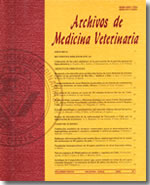Detection of Cryptosporidium spp. in calves by using a acid fast method and confirmed by immunochromatographic and molecular assays
Main Article Content
Abstract
From an animal production point of view, Cryptosporidium can cause great economic losses in systems that involve the raising of cattle by producing various degrees of diarrhea, particularly in calves that are less than 30 days of age. The main objective of this study was the detection of Cryptosporidium spp. oocysts in faecal samples of diarrheic calves of less than one month of age from two milk farms in the Metropolitan Region of Chile. For the first time in the country, an immunochromatographic and a molecular assay were used to confirm the microscopical observation of Cryptosporidium spp. oocysts in the bovine samples studied. A total of 205 fecal samples were stained with acid-fast method (Ziehl Neelsen, ZN) and 102 (49.8%) were found to have parasite oocysts. From these ZN positive samples, 58 were randomly selected and were all confirmed positive by the immunochromatographic test (IC). Conversely, 10 ZN negative samples were all negative by using IC test. A genus-specific molecular assay (18S ribosomal RNA PCR) was designed and carried out in the study of the 58 ZN/IC positive and the 10 ZN/IC negative faecal samples for the detection of Cryptosporidium spp. 37 (64%) samples were confirmed positive by this genus-specific PCR assay while all the 10 ZN/IC negative samples yielded no amplification. Detection limit of the genus-specific PCR was compared with the ZN staining method. Fewer parasites were detected by PCR (104 oocysts/mL) when compared to ZN (2 x 104 oocysts/mL). The results showed that cryptosporidiosis continues to be a parasitic infection of high frequency in dairy farm cattle in the Metropolitan Region. The ZN stain method is extremely operator dependent, but this disadvantage can be reduced by combining ZN with the IC test. Further studies are needed to improve the yield of the genus-specific PCR method as a diagnostic tool for bovine Cryptosporidium. Molecular tests also contribute to define the veterinary epidemiology of this parasitic infection in a specific geographical area.

